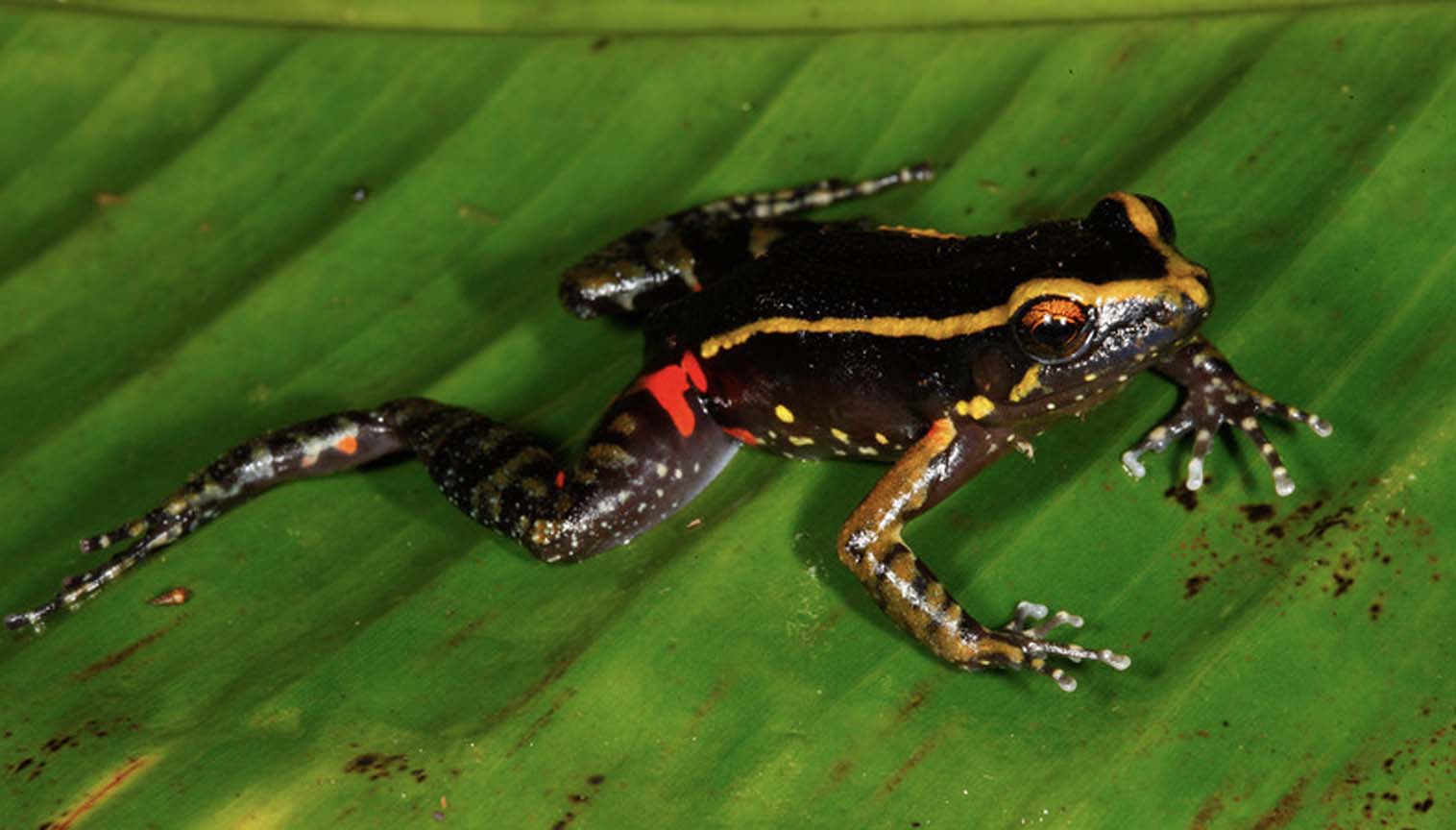Animals are created with various characteristics that help them survive, feed and defend themselves. One of the characteristics some animals have is camouflage, the art of blending into the environment. Camouflage, literally a show of intelligence and art, is at the same time a strategy of war. Throughout history, people have successfully fended off attacks by hiding themselves and their equipment using this method. This warfare tactic not only requires intelligence, but also training, skill and experience. Therefore, it is not a method that every person can easily employ.
However, many animals are excellent at camouflaging. In fact, they do it so well, nothing humans build can even be compared to their mastery. They sometimes change the color or shape of their bodies, sometimes stand just in the proper position while other times, they use odors to camouflage themselves.
The yellow-striped Amazonian frog, a species indigenous to South America, is an example of those animals that camouflage with odors.

Solving the Mystery of the Yellow-striped Amazonian Frog's Scent Camouflage
André Barros, from the National Institute of Amazon Studies in Brazil, conducted a study published in Behavioral Ecology and Sociobiology and uncovered the secret of the relationship between the tiny yellow-striped Amazonian frog and leaf-cutting ants.
The yellow-striped Amazonian frog (Lithodytes lineatus) is a South American frog species living in the Amazon region. This frog species lives, reproduces, and build its nests peacefully amongst the leaf-cutting ants of the "Atta" genus and they do so without being attacked by ants in any way. How does the frog manage to do this?
Leaf-cutting ants use chemical odors such as pheromones to recognize and communicate with members of their colony. According to researchers, this frog can live comfortably among ants because its skin is covered with chemicals similar to those produced by ants. These chemicals trick the leaf-cutting ants into perceiving the Amazonian frog as "friendly" and allow the frog to live among them.
The researchers performed two experiments to test the odor camouflage. First, the yellow-striped Amazonian frog and four similar frog species were kept in a glass container with some leaf-cutting ants for 10 minutes. The yellow-striped Amazonian frog did not make any escape attempts, but other frog species tried to jump or climb out after being attacked by ants.
Then, the researchers covered 20 Rhinella major frogs, which are common in the Amazon region, with either a skin extract of the yellow-striped Amazonian frog or ultra-pure water, and observed what happened. The 10 frogs covered with the skin extract were not attacked. But the ants attacked the other ultra-pure water-covered frogs.
Both experiments showed that the skin of the yellow-striped Amazonian frog contains chemicals that protected it from ants. This clearly explained why the ants and frogs could live together in harmony; because of these chemicals, the ants would not perceive the frog as a hunter, and they would consider it harmless. So, why is this camouflage important for a frog? Because it allows the frog to live comfortably and because the ant nests provide a stable microclimate and higher humidity to the frog. This is an important advantage for the reproduction of frogs and the development of their eggs.
The research showed that the odor camouflage of frogs has an impressively flawless structure.
Needless to say, the odor camouflage and the conscious behaviors of this frog species refute the very foundations of Darwinism. This is because the Atta ants' scent can be examined and mimicked only through comprehensive analyses in a chemical laboratory. It is impossible for a frog that lacks judgment or consciousness to know these pheromones and produce them in its own body without any chemistry knowledge or production platform, and to determine that they can live comfortably live among ants thanks to this odor. The intelligent behavior of these creatures can never be explained by coincidence, as Darwinism claims.
Just like all other living and non-living beings in nature, this characteristic of the yellow-striped Amazonian frog is also an example of the flawless art of Almighty God, visible even in the smallest details. In fact, our Almighty Lord informs us through a verse of the Holy Qur’an that there are explicit evidences in all living beings for mankind:
And in your creation and all the creatures He has spread about there are Signs for people with certainty. (Surah al-Jathiyya, 4)
FASCINATING SELF-DEFENSE METHODS OF ATTA ANTS The middle-sized workers of the leaf-cutter ant colony spend almost all their days transporting leaves. However, it becomes difficult for them to defend themselves during this transportation because they carry leaves with their jaws, which are their means of self-defense. So, who protects them when they cannot defend themselves? The leaf-carrying worker ants have been seen to travel in the constant company of smaller sized workers. At first, this was assumed to be an ordinary situation; but later, when researchers began investigating further, they uncovered a truly amazing collaboration. The worker ants, which normally manage to drive away the flies that try to perch on them via their scissor-like sharp jaws, cannot do so while they are transporting leaves. That is why they put these small-sized worker ants, which will defend them on their behalf, on the leaf they carry. During the flies attacks, these little protectors fight against the enemy from atop the leaves. |
SOURCE:
Springer. (2016, October 20). Amazonian frog has its own ant repellent: Chemicals presented on skin allow tiny frog to live and breed unhindered among leaf-cutting ants. ScienceDaily. www.sciencedaily.com/releases/2016/10/161020102644.htm


